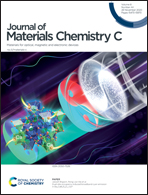Triethanolamine-assisted photodeposition of non-crystalline CuxP nanodots for boosting photocatalytic H2 evolution of TiO2†
Abstract
Exploiting highly efficient, noble metal-free, and ultra-small H2-evolution cocatalysts is crucial to promoting the photocatalytic water splitting reaction. Herein, ultra-small non-crystalline CuxP nanodots (CuxP-ND) as an efficient H2-evolution cocatalyst were coupled on the TiO2 surface via a simple triethanolamine (TEOA)-assisted photodeposition strategy. Owing to the initially uniform anchoring of the Cu(TEOA)2+ precursor on the TiO2 surface, the final CuxP nanodots show a very small size of 2–5 nm and are homogeneously distributed on the surface of the photocatalyst. The obtained CuxP-ND/TiO2 photocatalysts displayed a significantly enhanced ultraviolet-light H2-production activity and the CuxP-ND/TiO2(1 wt%) sample displayed a maximum hydrogen-production rate of 93.5 μmol h−1 with an apparent quantum efficiency of 7.7%, which is a 30-fold increase compared to bare TiO2. The boosted hydrogen generation can be ascribed to the fact that the ultra-small non-crystalline CuxP nanodots can not only induce the formation of a built-in electric field to improve the rapid transfer of photogenerated electrons, but also provide interfacial hydrogen-production sites to dramatically enhance the H2-generation rate. These new non-crystalline CuxP nanodots with a green and facile preparation procedure can pave a new way to exploit efficient co-catalysts for photocatalytic hydrogen evolution.



 Please wait while we load your content...
Please wait while we load your content...